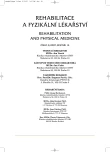-
Medical journals
- Career
Effects of Rehabilitation in Patients with Disorders of Temporomandibular Joint
Authors: P. Konečný 1,2; J. Havlíčková 1; M. Elfmark 1,3; P. Tvrdý 4; D. Hanáková 4; M. Jureček 4
Authors‘ workplace: Klinika rehabilitace a tělovýchovného lékařství LF UP a FN, Olomouc primář MUDr. A. Krobot, Ph. D 1; Neurologická klinika LF UP a FN, Olomouc přednosta doc. MUDr. P. Kaňovský, CSc. 2; Katedra biomechaniky a technické kybernetiky FTK UP, Olomouc vedoucí doc. Ing. J. Salinger, CSc. 3; Klinika ústní, čelistní a obličejové chirurgie LF UP a FN, Olomouc přednosta prof. MUDr. J. Pazdera, CSc. 4
Published in: Rehabil. fyz. Lék., 14, 2007, No. 3, pp. 95-100.
Category: Original Papers
Overview
Temporomandibular disorders (TMD) include various diseases affected temporomandibular joints and associated adjacent myofacial structures. The purpose of the contribution was to evaluate the function and dysfunction of temporomandibular joints in a patient with functional TMD before and after aimed rehabilitation and comparison of these changes with a group of healthy probands. The evaluation was performed by means of instrumental measurement – two dimensional video-kinematic analysis (2D-VKA) in sagital and frontal planes upon opening of the mouth.
The results of 2D-VKA indicate that in patients with TMD the opening of mouth is accompanied by a lateral deviation and a superfluous atypical protrusion of mandible in sagital plane. After the rehabilitation-reeducation therapy the locomotor functions are optimized and the opening of mouth is not accompanied by so marked (dysfunctional) deviations of the movement which is getting close to the path in healthy individuals.Key words:
temporomandibular dysfunction, video-kinematic analysis, rehabilitation, lateral pterygoid muscle
Sources
1. AU, A. R., KLINEBERG, I.: Isokinetic exercise management of temporomandibular Joint Clicking in Young Adults. Journal of Prosthetic Dentistry. 70, 1993,1, pp. 33-39.
2. BÍLÝ, B.: Fyzioterapie dysfunkčního syndromu čelistního kloubu. Prakt. zub. Lék., 23, 1975, s. 43-49.
3. BRAVETTI, P., MENBRE, H., EL HADDIOUI, A., GÉRARD, H., FYAD, J. P., MAHLER, P., GAUDY, J. F.: Histological study of the human temporomandibular joint and its surrounding muscles. Surgical and Radiologic Anatomy, 2004, 2, pp. 345-362.
4. ČIHÁK, R.: Anatomie I. Praha, Grada 2001, ISBN 80-7169-970.
5. FRIEDMAN, M. H., WEISEBERG, J. P. T. , WEBER, F.L.: Postsurgical temporomandibular joint hypomobility. Rehabilitation technique. Oral Surg Oral Med Oral Pathol, 75, 1993, 1, pp. 24-28.
6. HANÁKOVÁ, J., JUREČEK, B., KONEČNÝ, P: Zhodnocení efektu propriosenzitivního reedukačního cvičení při léčbě temporomandibulárních poruch. Čes. Stomatologie, 104, 2004, 5, s. 193-200.
7. HIRABA, K. HIBINO, K., HIRANUMA, K., NEGOR, T: EMG aktivity of two heads of the human lateral pterygoid muscle in relation to mandubular condyle movement and biting force. Journal of Neurophysiology, 4, 83, 2000, pp. 2120-2137.
8. KARDOŠ, J.: Etiologia funkčných porúch temporomandibulárnej artikulácie. Prakt. zub. Lék., 39, 1991, 3, s. 87-90.
9. KLEPÁŠEK, I., MAZÁNEK, J. et al: Klinická anatomie ve stomatologii. Praha, Grada, 2001, ISBN 80-7169-770-2.
10. KRUG, J., CEVALLOS-LECARO, M. D., GRUMMICHOVÁ, M.: Muskuloskeletální bolest. Bolest, 3, 2002, s. 146-151.
11. LEWIT, K.: Manipulační léčba. 1. vyd. Praha, Česká lékařská společnost J. E. Purkyně, 2003, ISBN 8086645045.
12. MENTELOVÁ, J.: Obnovenie funkcie izometrickými cvikmi pri kraniomandibulárnych poruchách. Stomatoloóg, 5, 1994, s. 184-188.
13. OKESON, J. P:. Management of temporomandibular disorders and occlusion. St. Luise: Mosby Year Book 1993.
14. OKESON, J. P.: Orofacial Pain. 1996. In: Wright et al. Usefulness of posture training for patients with temporomandibular disorders. Journal of the American Dental Association. 131, 2000, 2, pp. 202-210.
15. PETEROVÁ, V., JIRMAN, R., FIKÁČKOVÁ, H., MAZÁNEK, J.: Naše zkušenosti s MR vyšetřením temporomandibulárního kloubu. Čes. Stomatologie, 104, 2004, 4, s.160-167.
16. SCHLEIP, R.: New insights on the pterygoideus lateralis. [on-line] 2002, [cit. 2005-06-06]. Dostupné na internetu: <http://somatics/delMPL.htm>.
17. SOUMAR, L.: Kinematická analýza hybnosti mandibuly. UK FTVS Praha, katedra fyzioterapie, [on-line], 2002, [cit. 2005-11-23] Dostupné na internetu:
<http://www.ftvs.cuni.cz/pds/konference2/sekce%202/S-2-Soumar.doc>.
18. TVRDOŇ, M., KOTRÁŇ, M, MENTELOVÁ, J.: Protetická stomatologia. Léčba a prevencia, Bratislava, 1999, ISBN 80-967961-5-1.
19. VACEK, J., ZEMANOVÁ, M.: Temporomandibulární dysfunkce. Rehab. a fyz. Lék., 10, 2003, s.103-108.
20. XIAOJIANG, Y.: Magnetic resonance imaging of the lateral pterygoid muscle in temporomandibular disorders. [on-line] 2002, [cit. 2005-07-14] Dostupné na internetu: http://herkules.oulu.fi/isbn9514266439/html/index.html.
21. ZEMEN J.: Konzervativní léčba temporomandibulárních poruch. Praha, Galén, 1999a, ISBN 80-7262-005-3.
Labels
Physiotherapist, university degree Rehabilitation Sports medicine
Article was published inRehabilitation & Physical Medicine

2007 Issue 3-
All articles in this issue
- Effects of Rehabilitation in Patients with Disorders of Temporomandibular Joint
- SEMG Activity Monitoring of Selected Muscles in Nordic Walking and Plain Walking
- The Utilization of Electrical Stimulation in Rehabilitation after Radical Prostatectomy
- Diagnostics of Disorders of Sensor-motor Functions of the Hand in Patients after Ischemic Vascular Event (a Case Study)
- The Importance of Lateral Ankle Joint Ligaments
- Rehabilitation & Physical Medicine
- Journal archive
- Current issue
- Online only
- About the journal
Most read in this issue- The Importance of Lateral Ankle Joint Ligaments
- Diagnostics of Disorders of Sensor-motor Functions of the Hand in Patients after Ischemic Vascular Event (a Case Study)
- Effects of Rehabilitation in Patients with Disorders of Temporomandibular Joint
- The Utilization of Electrical Stimulation in Rehabilitation after Radical Prostatectomy
Login#ADS_BOTTOM_SCRIPTS#Forgotten passwordEnter the email address that you registered with. We will send you instructions on how to set a new password.
- Career

